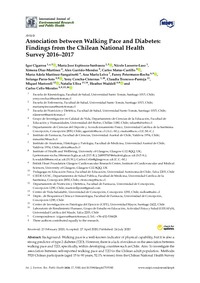Mostrar el registro sencillo de la publicación
Association between walking pace and diabetes: findings from the Chilean national health survey 2016–2017
| dc.contributor.author | Cigarroa, Igor | |
| dc.contributor.author | Espinoza-Sanhueza, María José | |
| dc.contributor.author | Lasserre-Laso, Nicole | |
| dc.contributor.author | Diaz-Martínez, Ximena | |
| dc.contributor.author | Garrido-Méndez, Alex | |
| dc.contributor.author | Matus-Castillo, Carlos | |
| dc.contributor.author | Martínez, María A. | |
| dc.contributor.author | Leiva, Ana M. | |
| dc.contributor.author | Petermann-Rocha, Fanny | |
| dc.contributor.author | Parra, Solange | |
| dc.contributor.author | Concha-Cisternas, Yeny | |
| dc.contributor.author | Troncoso-Pantoja, Claudia | |
| dc.contributor.author | Martorell, Miquel | |
| dc.contributor.author | Ulloa, Natalia | |
| dc.contributor.author | Waddell, Heather | |
| dc.contributor.author | Celis-Morales, Carlos | |
| dc.date.accessioned | 2020-11-12T12:13:54Z | |
| dc.date.available | 2020-11-12T12:13:54Z | |
| dc.date.issued | 2020 | |
| dc.identifier.uri | http://repositorio.ucm.cl/handle/ucm/3177 | |
| dc.description.abstract | Background: Walking pace is a well-known indicator of physical capability, but it is also a strong predictor of type 2 diabetes (T2D). However, there is a lack of evidence on the association between walking pace and T2D, specifically, within developing countries such as Chile. Aim: To investigate the association between self-reported walking pace and T2D in the Chilean adult population. Methods: 5520 Chilean participants (aged 15 to 90 years, 52.1% women) from the Chilean National Health Survey 2016–2017 were included in this cross-sectional study. Both walking pace (slow, average, and brisk) and diabetes data were collected through self-reported methods. Fasting blood glucose (reported in mg/dl) and glycosylated haemoglobin A (HbA1c) scores were determined via blood exams. Results: In the unadjusted model, and compared to people who reported a slow walking pace, those with average and brisk walking pace had lower blood glucose levels (β = −7.74 mg/dL (95% CI: −11.08 to −4.40) and β = −11.05 mg/dL (95% CI: −14.36 to −7.75), respectively) and lower HbA1c (β = −0.34% (95% CI: −0.57 to −0.11) and β= −0.72% (95% CI: −0.94 to −0.49)), respectively. After adjusting for sociodemographic, Body Mass Index and lifestyle factors, the association between glycaemia and HbA1c remained only for brisk walkers. Both the average and brisk walker categories had lower odds of T2D (OR: 0.59 (95% CI: 0.41 to 0.84) and (OR 0.48 (95% CI: 0.30 to 0.79), respectively). Conclusion: Brisk walkers were associated with lower blood glucose and HbA1c levels. Moreover, average to brisk walking pace also showed a lower risk for T2D. | es_CL |
| dc.language.iso | en | es_CL |
| dc.rights | Atribución-NoComercial-SinDerivadas 3.0 Chile | * |
| dc.rights.uri | http://creativecommons.org/licenses/by-nc-nd/3.0/cl/ | * |
| dc.source | International Journal of Environmental Research and Public Health, 17(15), 5341 | es_CL |
| dc.subject | Walking pace | es_CL |
| dc.subject | Diabetes mellitus | es_CL |
| dc.subject | Glucose | es_CL |
| dc.subject | Glycosylated haemoglobin A | es_CL |
| dc.subject | Health surveys | es_CL |
| dc.subject | Chile (MeSH) | es_CL |
| dc.title | Association between walking pace and diabetes: findings from the Chilean national health survey 2016–2017 | es_CL |
| dc.type | Article | es_CL |
| dc.ucm.indexacion | Scopus | es_CL |
| dc.ucm.indexacion | Isi | es_CL |
| dc.ucm.doi | doi.org/10.3390/ijerph17155341 | es_CL |



